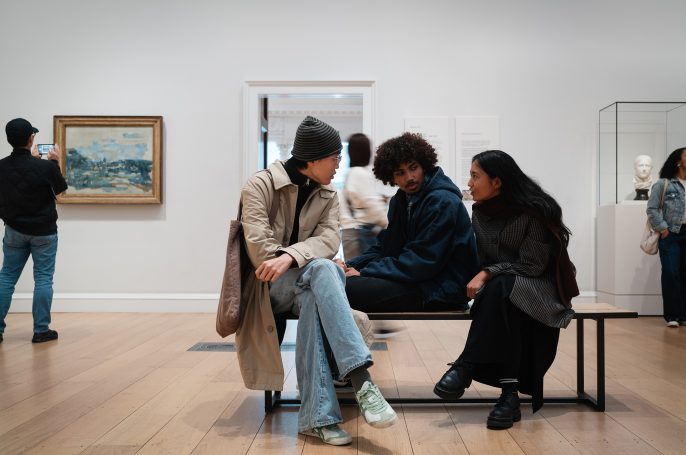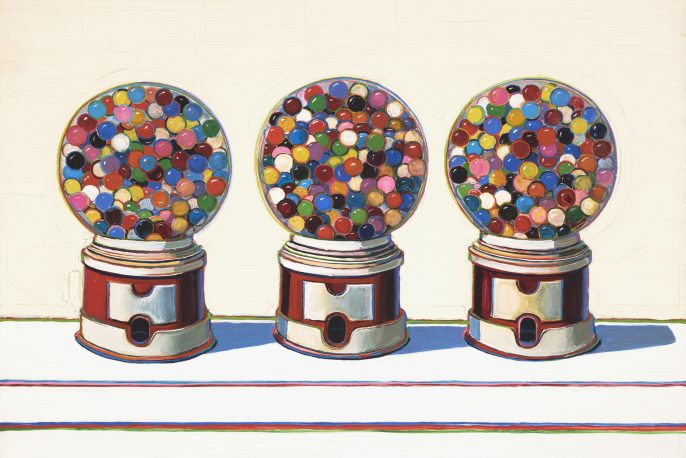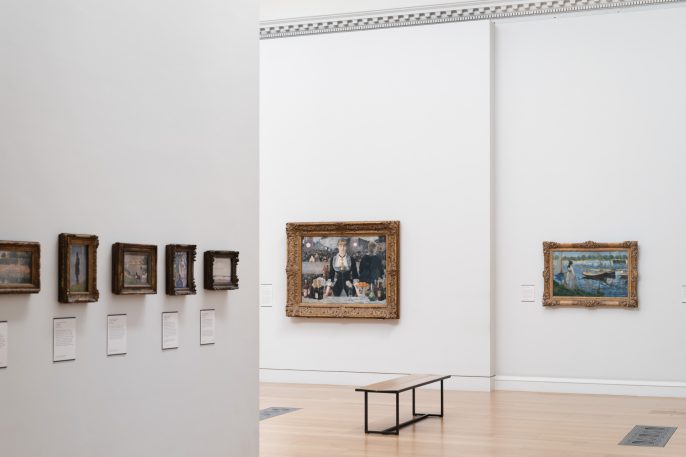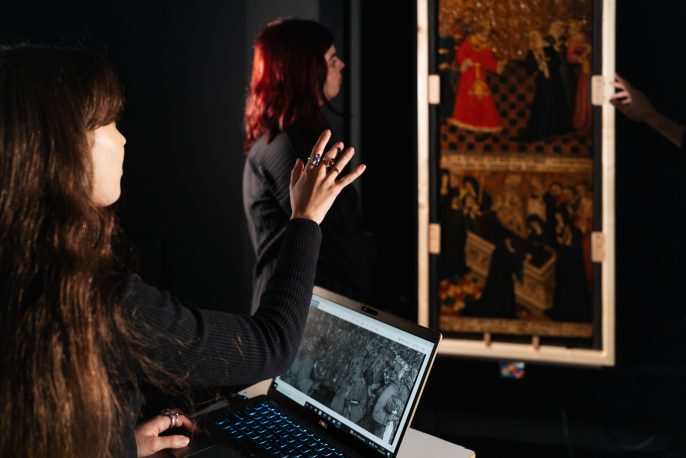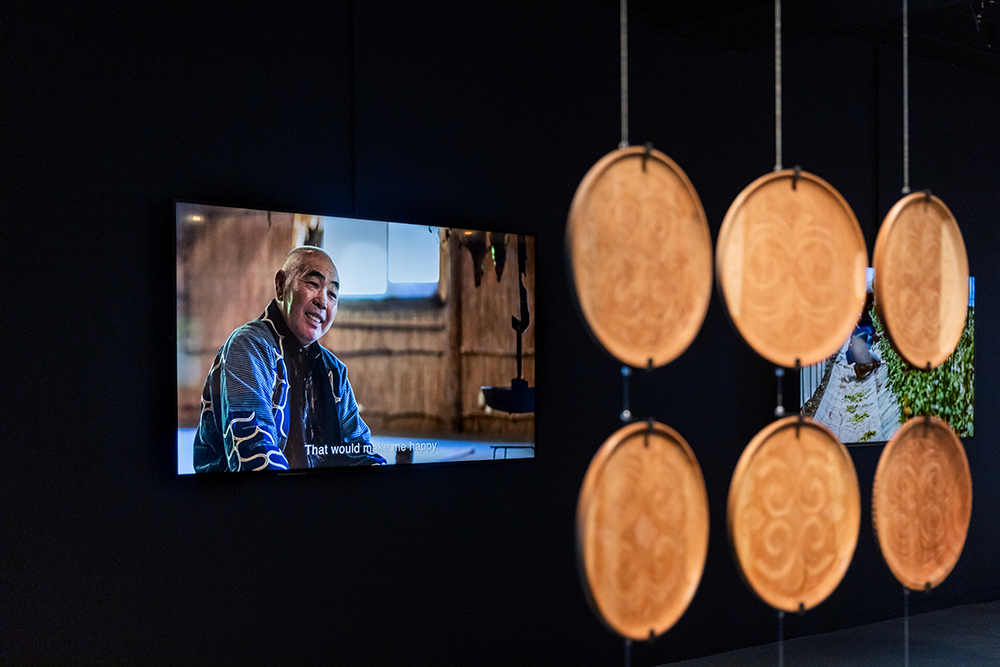
Japan House, London
16 November 2023 – 21 April 2024
On 16 November 2023, Japan House London launched the exhibition Ainu Stories: Contemporary Lives by the Saru River, which ran until 21 April 2024. Free to the public, the exhibition delved into the vibrant and resilient culture of the Ainu, the indigenous people of Hokkaido—Yuanmosir in Ainu. To this end, the exhibition was developed alongside the people of Biratori, in the Saru River basin.
The Ainu are ethnically and culturally distinct from their ethnic Japanese counterparts of Honshu—mainland Japan. Sustained historically through ‘fishing, hunting, and plant gathering,’ they also served as crucial conduits for exchange between Japan and its neighbours.1
Yet, Japanese involvement in Hokkaido was often fraught. Encroachment into Ainu lands began as early as the seventeenth century, reaching its height during the Meiji era drive for great-power status. Under the banner of bunmei-kaika—‘civilisation and enlightenment’—Japan’s rapid modernisation was undertaken in emulation of the West. Settler colonialism naturally followed: Ezo-chi, ‘the land of different peoples’; renamed Hokkaido by the Japanese government in 1869, declared terra nullius in 1872.2 The foundation for Japanese migration to Hokkaido was established—apropos the Ainu, laying the groundwork for their forced assimilation and cultural genocide.
The exhibition does attempt to address this past, albeit in a limited fashion. No mention occurs in the introduction to the exhibition; instead, acknowledgement can only be found in the section titled ‘Representation and Respect’—a two-dimensional sentence states the Meiji government ‘officially incorporated the lands of the Ainu into the territory of Japan and established the Hokkaido Development Commission to administer this new frontier.’ However, particular aspects of cultural repression that stemmed from this are rendered with greater attention. Prohibitions on cultural practices, including tattoos for women and ear piercings for men, or restrictions on conventional fishing nets and poison arrows for hunting—all marked as barbarous practices incompatible with a modern, civilised nation into which the Ainu were to be assimilated—are acknowledged as such by the exhibition, though as unintentionally harmful on the part of the Meiji government.
Yet, the core of the exhibition remains strongly in contemporary Ainu culture. Agency is brought into the fore; grassroots community action to counteract cultural erosion. Ainu Stories is, therefore, an apt title. Surrounding the exhibition space, videos featuring members of the community tell the story of the Biratori. Craftsmanship, food preparation, music, and dance emerge as vital methods to tell this narrative—alongside belief and ceremonial practice—all of which underscore the rich intangible heritage of the Ainu. Thematic islands provide glimpses into various aspects of Ainu culture. Particularly compelling is the display on language, effectively showcasing efforts to create a written form of Ainu language. An array of vocabulary cards is exhibited, designed to teach and preserve the language, a community-based initiative contrasted with an earlier dictionary created by English-American missionary John Batchelor. This curation underscores the community’s ongoing work to reclaim and document their language on their own terms, offering a powerful contrast to earlier external attempts.
The exhibits continue the importance of storytelling, including crucial information about the artisans behind the work. This is an important shift as historically the contributions of many indigenous communities have been overlooked or erased, with a focus on artefacts rather than their creators. Kaizawa Mituo is one such artisan. A renowned woodworker, his tools were donated by his widow to preserve his knowledge and pass on woodworking skills to future generations. These tools embody a living legacy of Ainu culture. Intergenerational knowledge is further highlighted as significant, vividly illustrated by Nibutani woodcarvers actively passing down their skills to the younger generations. The ita—wooden plates and trays—specially crafted by these artisans for the exhibition are not just functional objects but a testament to this living tradition. These works speak to the agency of the community, showcasing how they use inherited knowledge to create pieces that embody both cultural survival and contemporary relevance. The Nibutani Craft Cooperative Association further reinforces this, preserving traditional methods and tools, ensuring these practices thrive in a modern context. Together, these artisans and their work demonstrate how cultural knowledge is a powerful tool for both preservation and self-representation.
Wood carvings and textiles feature strongly, revealing a story of continuity and revival through their continued influence on broader aspects of Ainu visual culture today. Decorative ita display carved pattern forms found across Ainu woodwork and textiles, are exhibited alongside a brand of tomato juice that originated from Biratori in 1986, Nispa’s Lover, which incorporates ayus-noka (thorn patterns) into its branding. Ainu craftsmanship finds new life in modern contexts, weaving traditional designs into contemporary products. In raising these connections, Ainu Stories also notes the basis of nature for pattern forms, such as the ram-ram-noka (fish scale pattern), which continue to adorn contemporary objects, ensuring the survival and relevance of Ainu aesthetics.
A growing interest in Ainu culture is evident through inclusion of the popular manga Golden Kamuy, which weaves Ainu heritage into its narrative, demonstrating the power of popular media in preserving traditional culture. Mangaka Satoru Noda’s use of authentic elements, such as a knife modelled after one crafted by Nibutani woodcarver Kaizawa Tōru, further highlights how traditional craftsmanship is hybridised with modern storytelling. Together, these examples illustrate how Ainu craftsmanship finds new life in modern contexts, ensuring the survival and relevance of Ainu aesthetics in mainstream culture.
The exhibition highlights the enduring connection between Ainu artisans and their natural environment, showcasing their adaptability across both traditional and contemporary contexts. This is particularly across both traditional and contemporary contexts. This is particularly evident through the innovative use of natural resources, such as salmon skin, transferred into practical and wearable items like cepker. Derived from ci(we), ep (eat), and ker (shoes), these boots reflect the Ainu’s reliance on salmon as both a vital food source and a material for craftsmanship. This resourcefulness extends to the creation of attus (bark cloth) from wood fibres, with the intricate process from bark to yarn exhibited. Clothing such as attus amip—robes made from elm-bark cloth—underscore the Ainu’s deep-rooted connection to nature and their ability to sustain these cultural practices through careful adaption.
The exhibition’s multifaceted approach to the survival and contemporary relevance of Ainu culture was not isolated to its displays. Instead, it formed only one aspect of a broader programme of events designed to immerse visitors into Ainu heritage. Screenings of Ainu filmmakers’ work, such as Ainu Neno Au Ainu, showcase life in Nibutani and the community efforts to preserve their language and culture despite a history of colonisation. Embroidery lessons and woodcarving sessions allowed participants to engage directly with Ainu crafts, acting as a means of cultural transmission and preservation. Food tasting events enriched this further, offering a chance to savour Ainu cuisine and, therefore, participate in the stories that food can tell. Collectively, these activities fostered a deeper understanding and appreciation of Ainu heritage, demonstrating the importance of interactive and participatory methods in maintaining and promoting the cultural identity of the Ainu today.
Even after its closure, Ainu Stories: Contemporary Lives by the Saru River leaves a lasting impression on its visitors. The exhibition gives agency to often endangered elements of culture—craftsmanship, language, and ecological equilibrium—by placing them at the heart of the Ainu narrative. Through this, it not only highlights the resilience of the Ainu, but also speaks to the broader significance of preserving both material and intangible heritage across indigenous and traditional communities worldwide. While primarily catering to an audience unfamiliar with Ainu culture, Ainu Stories effectively demonstrates the role these endangered practices play in cultural survival, though future exhibitions could offer more ambitions explorations of the complexities of Ainu life and the broader struggles of indigenous communities.
Citations
[1] Japan House London, Ainu Stories: Contemporary Lives by the Saru River (London: Japan House, 2023), 4.
[2] Katsuya Hirano, ‘Thanatopolitics in the Making of Japan’s Hokkaido: Settler Colonialism and Primitive Accumulation,’ Critical Historical Studies 2, no. 2 (Fall 2015), 192, 197.
